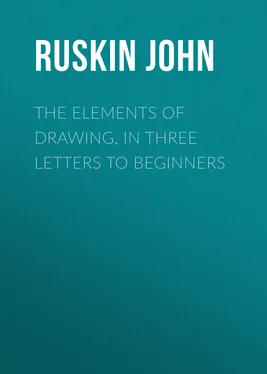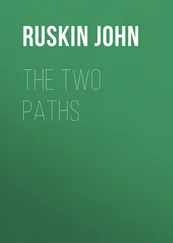John Ruskin - The Elements of Drawing, in Three Letters to Beginners
Здесь есть возможность читать онлайн «John Ruskin - The Elements of Drawing, in Three Letters to Beginners» — ознакомительный отрывок электронной книги совершенно бесплатно, а после прочтения отрывка купить полную версию. В некоторых случаях можно слушать аудио, скачать через торрент в формате fb2 и присутствует краткое содержание. Жанр: foreign_antique, foreign_home, literature_19, visual_arts, на английском языке. Описание произведения, (предисловие) а так же отзывы посетителей доступны на портале библиотеки ЛибКат.
- Название:The Elements of Drawing, in Three Letters to Beginners
- Автор:
- Жанр:
- Год:неизвестен
- ISBN:нет данных
- Рейтинг книги:4 / 5. Голосов: 1
-
Избранное:Добавить в избранное
- Отзывы:
-
Ваша оценка:
- 80
- 1
- 2
- 3
- 4
- 5
The Elements of Drawing, in Three Letters to Beginners: краткое содержание, описание и аннотация
Предлагаем к чтению аннотацию, описание, краткое содержание или предисловие (зависит от того, что написал сам автор книги «The Elements of Drawing, in Three Letters to Beginners»). Если вы не нашли необходимую информацию о книге — напишите в комментариях, мы постараемся отыскать её.
The Elements of Drawing, in Three Letters to Beginners — читать онлайн ознакомительный отрывок
Ниже представлен текст книги, разбитый по страницам. Система сохранения места последней прочитанной страницы, позволяет с удобством читать онлайн бесплатно книгу «The Elements of Drawing, in Three Letters to Beginners», без необходимости каждый раз заново искать на чём Вы остановились. Поставьте закладку, и сможете в любой момент перейти на страницу, на которой закончили чтение.
Интервал:
Закладка:
xiii. In modern days, I doubt if any artist among us, except David Roberts, knows so much perspective as would enable him to draw a Gothic arch to scale at a given angle and distance. Turner, though he was professor of perspective to the Royal Academy, did not know what he professed, and never, as far as I remember, drew a single building in true perspective in his life; he drew them only with as much perspective as suited him. Prout also knew nothing of perspective, and twisted his buildings, as Turner did, into whatever shapes he liked. I do not justify this; and would recommend the student at least to treat perspective with common civility, but to pay no court to it. The best way he can learn it, by himself, is by taking a pane of glass, fixed in a frame, so that it can be set upright before the eye, at the distance at which the proposed sketch is intended to be seen. Let the eye be placed at some fixed point, opposite the middle of the pane of glass, but as high or as low as the student likes; then with a brush at the end of a stick, and a little body-color that will adhere to the glass, the lines of the landscape may be traced on the glass, as you see them through it. When so traced they are all in true perspective. If the glass be sloped in any direction, the lines are still in true perspective, only it is perspective calculated for a sloping plane, while common perspective always supposes the plane of the picture to be vertical. It is good, in early practice, to accustom yourself to inclose your subject, before sketching it, with a light frame of wood held upright before you; it will show you what you may legitimately take into your picture, and what choice there is between a narrow foreground near you, and a wide one farther off; also, what height of tree or building you can properly take in, etc. 2 2 If the student is fond of architecture, and wishes to know more of perspective than he can learn in this rough way, Mr. Runciman (of 49 Acacia Road, St. John's Wood), who was my first drawing-master, and to whom I owe many happy hours, can teach it him quickly, easily, and rightly. [Mr. Runciman has died since this was written: Mr. Ward's present address is Bedford Chambers, 28 Southampton Street, Strand, London, W.C.]
xiv. Of figure drawing, nothing is said in the following pages, because I do not think figures, as chief subjects, can be drawn to any good purpose by an amateur. As accessaries in landscape, they are just to be drawn on the same principles as anything else.
xv. Lastly: If any of the directions given subsequently to the student should be found obscure by him, or if at any stage of the recommended practice he find himself in difficulties which I have not enough provided against, he may apply by letter to Mr. Ward, who is my under drawing-master at the Working Men's College (45 Great Ormond Street), and who will give any required assistance, on the lowest terms that can remunerate him for the occupation of his time. I have not leisure myself in general to answer letters of inquiry, however much I may desire to do so; but Mr. Ward has always the power of referring any question to me when he thinks it necessary. I have good hope, however, that enough guidance is given in this work to prevent the occurrence of any serious embarrassment; and I believe that the student who obeys its directions will find, on the whole, that the best answerer of questions is perseverance; and the best drawing-masters are the woods and hills.
[1857.]
THE ELEMENTS OF DRAWING
LETTER I.
ON FIRST PRACTICE
1. My dear Reader,—Whether this book is to be of use to you or not, depends wholly on your reason for wishing to learn to draw. If you desire only to possess a graceful accomplishment, to be able to converse in a fluent manner about drawing, or to amuse yourself listlessly in listless hours, I cannot help you: but if you wish to learn drawing that you may be able to set down clearly, and usefully, records of such things as cannot be described in words, either to assist your own memory of them, or to convey distinct ideas of them to other people; if you wish to obtain quicker perceptions of the beauty of the natural world, and to preserve something like a true image of beautiful things that pass away, or which you must yourself leave; if, also, you wish to understand the minds of great painters, and to be able to appreciate their work sincerely, seeing it for yourself, and loving it, not merely taking up the thoughts of other people about it; then I can help you, or, which is better, show you how to help yourself.
2. Only you must understand, first of all, that these powers, which indeed are noble and desirable, cannot be got without work. It is much easier to learn to draw well, than it is to learn to play well on any musical instrument; but you know that it takes three or four years of practice, giving three or four hours a day, to acquire even ordinary command over the keys of a piano; and you must not think that a masterly command of your pencil, and the knowledge of what may be done with it, can be acquired without painstaking, or in a very short time. The kind of drawing which is taught, or supposed to be taught, in our schools, in a term or two, perhaps at the rate of an hour's practice a week, is not drawing at all. It is only the performance of a few dexterous (not always even that) evolutions on paper with a black-lead pencil; profitless alike to performer and beholder, unless as a matter of vanity, and that the smallest possible vanity. If any young person, after being taught what is, in polite circles, called "drawing," will try to copy the commonest piece of real work—suppose a lithograph on the titlepage of a new opera air, or a wood-cut in the cheapest illustrated newspaper of the day,—they will find themselves entirely beaten. And yet that common lithograph was drawn with coarse chalk, much more difficult to manage than the pencil of which an accomplished young lady is supposed to have command; and that wood-cut was drawn in urgent haste, and half spoiled in the cutting afterwards; and both were done by people whom nobody thinks of as artists, or praises for their power; both were done for daily bread, with no more artist's pride than any simple handicraftsmen feel in the work they live by.
3. Do not, therefore, think that you can learn drawing, any more than a new language, without some hard and disagreeable labor. But do not, on the other hand, if you are ready and willing to pay this price, fear that you may be unable to get on for want of special talent. It is indeed true that the persons who have peculiar talent for art, draw instinctively, and get on almost without teaching; though never without toil. It is true, also, that of inferior talent for drawing there are many degrees: it will take one person a much longer time than another to attain the same results, and the results thus painfully attained are never quite so satisfactory as those got with greater ease when the faculties are naturally adapted to the study. But I have never yet, in the experiments I have made, met with a person who could not learn to draw at all; and, in general, there is a satisfactory and available power in every one to learn drawing if he wishes, just as nearly all persons have the power of learning French, Latin, or arithmetic, in a decent and useful degree, if their lot in life requires them to possess such knowledge.
4. Supposing then that you are ready to take a certain amount of pains, and to bear a little irksomeness and a few disappointments bravely, I can promise you that an hour's practice a day for six months, or an hour's practice every other day for twelve months, or, disposed in whatever way you find convenient, some hundred and fifty hours' practice, will give you sufficient power of drawing faithfully whatever you want to draw, and a good judgment, up to a certain point, of other people's work: of which hours if you have one to spare at present, we may as well begin at once.
Читать дальшеИнтервал:
Закладка:
Похожие книги на «The Elements of Drawing, in Three Letters to Beginners»
Представляем Вашему вниманию похожие книги на «The Elements of Drawing, in Three Letters to Beginners» списком для выбора. Мы отобрали схожую по названию и смыслу литературу в надежде предоставить читателям больше вариантов отыскать новые, интересные, ещё непрочитанные произведения.
Обсуждение, отзывы о книге «The Elements of Drawing, in Three Letters to Beginners» и просто собственные мнения читателей. Оставьте ваши комментарии, напишите, что Вы думаете о произведении, его смысле или главных героях. Укажите что конкретно понравилось, а что нет, и почему Вы так считаете.












